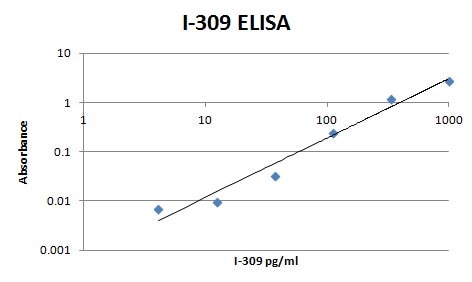Recombinant Human CCL1/I-309 Protein Summary
Product Specifications
Lys24-Lys96
Analysis
Product Datasheets
Carrier Free
CF stands for Carrier Free (CF). We typically add Bovine Serum Albumin (BSA) as a carrier protein to our recombinant proteins. Adding a carrier protein enhances protein stability, increases shelf-life, and allows the recombinant protein to be stored at a more dilute concentration. The carrier free version does not contain BSA.
In general, we advise purchasing the recombinant protein with BSA for use in cell or tissue culture, or as an ELISA standard. In contrast, the carrier free protein is recommended for applications, in which the presence of BSA could interfere.
272-I
| Formulation | Lyophilized from a 0.2 μm filtered solution in Acetonitrile and TFA with BSA as a carrier protein. |
| Reconstitution | Reconstitute at 100 μg/mL in sterile PBS containing at least 0.1% human or bovine serum albumin. |
| Shipping | The product is shipped at ambient temperature. Upon receipt, store it immediately at the temperature recommended below. |
| Stability & Storage: | Use a manual defrost freezer and avoid repeated freeze-thaw cycles.
|
272-I/CF
| Formulation | Lyophilized from a 0.2 μm filtered solution in Acetonitrile and TFA. |
| Reconstitution | Reconstitute at 100 μg/mL in sterile PBS. |
| Shipping | The product is shipped at ambient temperature. Upon receipt, store it immediately at the temperature recommended below. |
| Stability & Storage: | Use a manual defrost freezer and avoid repeated freeze-thaw cycles.
|
Reconstitution Calculator
Background: CCL1/I-309/TCA-3
Human CCL1 was initially identified by subtractive hybridization as a transcript that was present in a gamma /δ T cell line but not in EBV-transformed B cells. Human CCL1 has been assumed to be a homologue of the mouse TCA3. While the two proteins share only approximately 42% amino acid sequence identity, both chemokines contain an extra pair of cysteine residues not found in most other chemokines. Human CCL1 and mouse TCA3 also share significant sequence homology in the 5’ flanking region of their genes.
CCL1 cDNA encodes a 96 amino acid residue precursor protein with a hydrophobic signal peptide that is cleaved to yield a 73 amino acid residue mature protein. The CCL1 sequence contains one potential N-linked glycosylation site and natural CCL1 secreted by activated T cells is a glycoprotein doublet of 15 - 16 kDa. The amino acid sequence of CCL1 identified the protein as a member of the chemokine beta subfamily.
- Miller, M.D. and M.S. Krangel (1992) Proc. Natl. Acad. Sci USA 89:2950.
- Miller, M.D. et al. (1990) J. Immunol. 145:2737.
Citations for Recombinant Human CCL1/I-309 Protein
R&D Systems personnel manually curate a database that contains references using R&D Systems products. The data collected includes not only links to publications in PubMed, but also provides information about sample types, species, and experimental conditions.
10
Citations: Showing 1 - 10
Filter your results:
Filter by:
-
Structural basis of antibody inhibition and chemokine activation of the human CC chemokine receptor 8
Authors: Sun, D;Sun, Y;Janezic, E;Zhou, T;Johnson, M;Azumaya, C;Noreng, S;Chiu, C;Seki, A;Arenzana, TL;Nicoludis, JM;Shi, Y;Wang, B;Ho, H;Joshi, P;Tam, C;Payandeh, J;Comps-Agrar, L;Wang, J;Rutz, S;Koerber, JT;Masureel, M;
Nature communications
Species: Hamster, Human
Sample Types: Transfected Whole Cells
Applications: Bioassay -
CC chemokine CCL1 receptor CCR8 mediates conversion of mesenchymal stem cells to embryoid bodies expressing FOXP3+CCR8+ regulatory T cells
Authors: NS Haque, A Tuteja, N Haque
PLoS ONE, 2019-07-17;14(7):e0218944.
Species: Human
Sample Types: Whole Cells
Applications: Cell Culture -
CCR8(+)FOXp3(+) Treg cells as master drivers of immune regulation
Authors: Y Barsheshet, G Wildbaum, E Levy, A Vitenshtei, C Akinseye, J Griggs, SA Lira, N Karin
Proc. Natl. Acad. Sci. U.S.A., 2017-05-22;0(0):.
Species: Human
Sample Types: Whole Cells
Applications: Bioassay -
Widespread potential for growth-factor-driven resistance to anticancer kinase inhibitors.
Authors: Wilson TR, Fridlyand J, Yan Y, Penuel E, Burton L, Chan E, Peng J, Lin E, Wang Y, Sosman J, Ribas A, Li J, Moffat J, Sutherlin DP, Koeppen H, Merchant M, Neve R, Settleman J
Nature, 2012-07-26;487(7408):505-9.
Species: Human
Sample Types: Whole Cells
Applications: Bioassay -
Mouse CCL8, a CCR8 agonist, promotes atopic dermatitis by recruiting IL-5+ T(H)2 cells.
Authors: Islam SA, Chang DS, Colvin RA
Nat. Immunol., 2011-01-09;12(2):167-77.
Species: Mouse
Sample Types: Whole Cells
Applications: Bioassay -
CC chemokine ligand 1 is released into the airways of atopic asthmatics.
Authors: Montes-Vizuet R, Vega-Miranda A, Valencia-Maqueda E, Negrete-Garcia MC, Velasquez JR, Teran LM
Eur. Respir. J., 2006-03-15;28(1):59-67.
Species: Human
Sample Types: BALF, Cell Culture Supernates, N/A
Applications: Bioassay, ELISA (Standard) -
Genetic fusions with viral chemokines target delivery of nonimmunogenic antigen to trigger antitumor immunity independent of chemotaxis.
Authors: Ruffini PA, Biragyn A, Coscia M, Harvey LK, Cha SC, Bogen B, Kwak LW
J. Leukoc. Biol., 2004-04-09;76(1):77-85.
Species: Human, Mouse
Sample Types: Whole Cells
Applications: Bioassay -
Expression of functional CCR and CXCR chemokine receptors in podocytes.
Authors: Huber TB, Reinhardt HC, Exner M, Burger JA, Kerjaschki D, Saleem MA, Pavenstadt H
J. Immunol., 2002-06-15;168(12):6244-52.
Species: Human
Sample Types: Whole Cells
Applications: Bioassay -
Stromal-derived factor 1 inhibits the cycling of very primitive human hematopoietic cells in vitro and in NOD/SCID mice.
Authors: Cashman J, Clark-Lewis I, Eaves A, Eaves C
Blood, 2002-02-01;99(3):792-9.
Species: Human
Sample Types: Whole Cells
Applications: Bioassay -
A cytokine-to-chemokine axis between T lymphocytes and keratinocytes can favor Th1 cell accumulation in chronic inflammatory skin diseases.
Authors: Albanesi C, Scarponi C, Sebastiani S, Cavani A, Federici M, Sozzani S, Girolomoni G
J. Leukoc. Biol., 2001-10-01;70(4):617-23.
Applications: ELISA (Standard)
FAQs
No product specific FAQs exist for this product, however you may
View all Proteins and Enzyme FAQsReviews for Recombinant Human CCL1/I-309 Protein
Average Rating: 4.5 (Based on 2 Reviews)
Have you used Recombinant Human CCL1/I-309 Protein?
Submit a review and receive an Amazon gift card.
$25/€18/£15/$25CAN/¥75 Yuan/¥2500 Yen for a review with an image
$10/€7/£6/$10 CAD/¥70 Yuan/¥1110 Yen for a review without an image
Filter by:
Reason for Rating: SEC elution consistent with expected MW, material appears to be good quality. Resolution may be improved with additional material and method development




